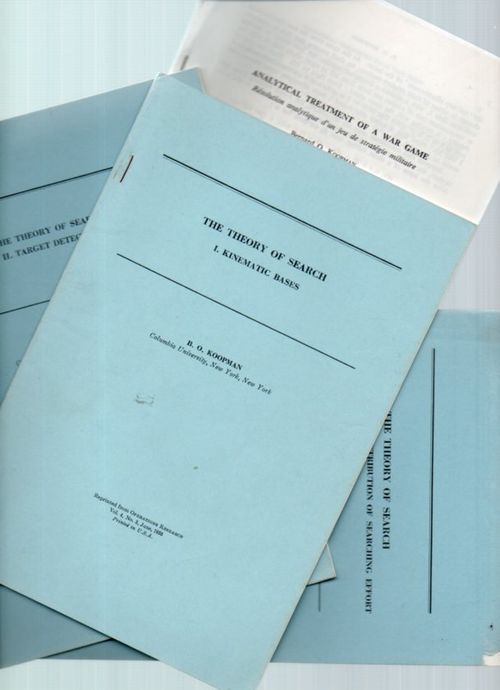B.O. Koopman. Four offprints. $250
"The Theory of Search. I: Kinematic Bases."1956. Pp 324-346. Offprint.
"The Theory of Seach II: Target Detection. " 1956. Pp 503-531.
"The Theory of Search III: the Optimum Distribution of Searching Effort." 1957. Pp 613-626.
All offprints from Operations Research. All in matching pale blue wrappers.
Offered with:
"Analytical Treatment of a War Game. 5pp. Original printed wrappers. No place or date of publication.
Abstract (A):
"In the conventional search situation, there are three general features. I The kinematic bases, involving the positions, geometrical configurations, and motions in the searchers and targets, with particular reference to the statistics of their contacts and the probabilities of their reaching various specified relative positions. II The probabilistic behavior of the instrument of detection (eye, radar, sonar, etc) when making a given passage relative to the target. III The over-all result—the probability of contact under general stated conditions, along with the possibility of optimizing the results by improving the methods of directing the search.
"The present paper is devoted to the first feature, and is intended to provide the kinematic bases of the theory. It studies fairly simple cases of relative motion and draws inspiration from the kinetic theory of matter. The second paper, entitled Target Detection, will deal with the second feature. It is based on the methods of survival probabilities familiar in actuarial studies, and is, it must be emphasized, confined to the case of independent trials. A third paper will deal with an important aspect of the third feature, and will be entitled The Optimum Distribution of Searching Effort. It represents the continuous extension of a paper of a similar title published by the author in Operations Research in February 1953."
Abstract (B):
“Kinematic bases,” the first paper of this series, discussed the geometric and kinematic factors involved in search—the positions, motions, and contacts of observers and targets. Probability was introduced only in assuming specific relative positions for the observer and target.
The present paper discusses the uncertainties inherent in the act of detection under various specific conditions of contact. In the course of the discussion a body of methods for applying probability to problems of detection is developed. It must be emphasized, however, that these methods are conditioned by the particular situation in the case of visual detection because the different elementary acts of looking or “glimpses” are essentially independent trials."





Comments